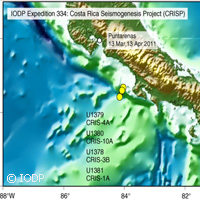Pacific-based earthquake triggers in the spotlight
An international team of researchers is unearthing the triggering mechanisms behind large, destructive earthquakes like the Tohoku earthquake that hit Japan last March. Led by the University of Florence in Italy, the researchers collected new samples of rock and sediment from the depths of the Pacific Ocean. The team retrieved almost 1 500 metres of core from the ocean floor not far from the coast of Costa Rica in South America. Supported by the scientific drilling vessel JOIDES Resolution during the latest Integrated Ocean Drilling Program (IODP) Costa Rica Seismogenesis Project (CRISP) Expedition, the samples provide key information in relation to 2 million years of tectonic activity along a seismic plate boundary. The scientists say they will use the samples to fuel our understanding of the processes that control the components that set off large earthquakes at subduction zones, where one plate slides beneath another. 'We know that there are different factors that contribute to seismic activity,' says Professor Paola Vannucchi of the University of Florence, who co-led the expedition with Dr Kohtaro Ujiie of the University of Tsukuba in Japan. 'These include rock type and composition, temperature differences, and how water moves within the Earth's crust, but what we don't fully understand is how these factors interact with one another and if one may be more important than another in leading up to different magnitudes of earthquakes. This expedition provided us with crucial samples for answering some of these fundamental questions.' Over three quarters of the planet's earthquakes with a magnitude of 8.0 and above occur along subduction zones. The Pacific Ocean is a hub for such boundaries, what experts call convergent margins. Specifically, they are found along the coasts of the East Pacific from the United States' state of Alaska in the north down to Patagonia, an area between Argentina and Chile in the south, as well as Tonga, Marianas, New Zealand, to Japan and the Aleutians. Researchers are particularly keen to study this area with the triggering mechanisms of big earthquakes. Over the period of one month, the scientists and crew aboard the vessel drilled four sites; they recovered core samples of sand and clay-like sediment and basalt rock. CRISP scientists noted in a preliminary report released in June that they found evidence for a strong subsidence, or sinking, of the Costa Rica margin combined with a large volume of sediment discharged from the continent and accumulated in the last 2 million years. 'The sediment samples provide novel information on different parameters which may regulate the mechanical state of the plate interface at depth,' Dr Ujiie says. 'Knowing how the plates interact at the fault marking their boundary is critical to interpreting the behaviour and frequency of earthquakes in the region.' Says Professor Vannucchi: 'For example we now know that fluids from deeper parts of the subduction zone system have percolated up through the layers of sediment. Studying the composition and volume of these fluids, as well as how they have moved through the sediment helps us better understand the relationship between the chemical, thermal, and mass transfer activity in the seafloor and the earthquake-generating, or seismogenic, region of the plate boundary. They may be correlated.' Other team members are currently analysing the cores obtained during the expedition. The preliminary results will be disseminated in August at Texas A&M University in the United States. The CRISP team anticipates returning to the same drill site in the future to directly sample the plate boundary and fault zone before and after seismic activity in the region. The changes discovered by the researchers could shed new light on how earthquakes emerge. This expedition is one of a kind because the work involved targets the properties of erosional convergent margins, where subduction processes 'eat' the overriding plates. The researchers say these plate boundaries are characterised by trenches with thin sediment cover, less than 400 metres, fast convergence between the plates and abundant seismicity.For more information, please visit: Integrated Ocean Drilling Program Management International:http://www.iodp.org/University of Florence:http://www.unifi.it/mdswitch.html
Countries
Costa Rica, Italy, Japan, United States



